 |
The overriding challenge of twentieth-century music has been progress with integrity.  Once tonality had run its course, some pursued further innovation through bypassing traditional notions of melody, harmony, rhythm and structure altogether, but they alienated much of their audience in the process. Most of the best-known composers averted that peril by clinging to the popular models of the past and lapsed into recycling formulae of the previous century. Carl Orff, though, looked back even further, to the era before tonality had begun. Once tonality had run its course, some pursued further innovation through bypassing traditional notions of melody, harmony, rhythm and structure altogether, but they alienated much of their audience in the process. Most of the best-known composers averted that peril by clinging to the popular models of the past and lapsed into recycling formulae of the previous century. Carl Orff, though, looked back even further, to the era before tonality had begun.
Rather than remain just another one among the legions of minor composers of his time, Orff redirected his work toward a far more lasting goal.  In 1925 he co-founded the G�ntherschule, a Munich school where he developed and applied an innovative method of musical education that revolutionized teaching and still wields enormous influence. As he later recounted in his Schulwerk (Schott, 1950), children rebel against being plunged into the boring technical exercises and "polite minuets, insipid rondos and empty sonatinas" in most practice books. The key to the Orff method is so simple it now seems obvious – recognizing that kids are kids rather than miniature adults and that they must first experience and internalize music on a meaningful level before formal training. Orff thoroughly integrated music into gymnastics, dance and play through bodily movements and speech patterns that trace the development of music from its primordial roots. Students should enter into serious study and learn formal vocabulary only once they revel in its natural elements by participating in creating ensemble music, feeling the relationship of its elements, listening to other performers and grasping its power to communicate. In 1925 he co-founded the G�ntherschule, a Munich school where he developed and applied an innovative method of musical education that revolutionized teaching and still wields enormous influence. As he later recounted in his Schulwerk (Schott, 1950), children rebel against being plunged into the boring technical exercises and "polite minuets, insipid rondos and empty sonatinas" in most practice books. The key to the Orff method is so simple it now seems obvious – recognizing that kids are kids rather than miniature adults and that they must first experience and internalize music on a meaningful level before formal training. Orff thoroughly integrated music into gymnastics, dance and play through bodily movements and speech patterns that trace the development of music from its primordial roots. Students should enter into serious study and learn formal vocabulary only once they revel in its natural elements by participating in creating ensemble music, feeling the relationship of its elements, listening to other performers and grasping its power to communicate.
The predominant force is rhythm, derived from the subconscious patterns of nature – heartbeats, breathing, walking. Speech patterns begin with prehistoric nonsense syllables and familiar nursery rhymes. The first lessons use the body as an instrument, with clapping hands, patting thighs, stamping feet and snapping fingers. 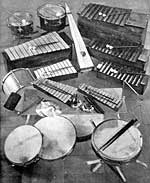 Students then transfer these instinctive, rudimentary rhythms and words to percussion instruments specially adapted to the physical requirements of youngsters. Improvisation is encouraged through use of a pentatonic scale (C-major without Fs and Bs), a mode of expressive sound sufficiently exotic to discourage mere imitation of conventional music, yet thoroughly pleasant, as none of the tones combine into discord. Students then transfer these instinctive, rudimentary rhythms and words to percussion instruments specially adapted to the physical requirements of youngsters. Improvisation is encouraged through use of a pentatonic scale (C-major without Fs and Bs), a mode of expressive sound sufficiently exotic to discourage mere imitation of conventional music, yet thoroughly pleasant, as none of the tones combine into discord.
After a decade of working with children, Orff came upon the means to apply his method to the theatre – an 1847 collection of 200 13th century poems written in Latin, German and French, that had been found in the library of the Bavarian Benediktbeuern monastery, near Munich, where Orff spent his entire life. Essentially counterculture protest songs, they had been written by the Golliards, a roving band of students and lapsed clerics who mocked authority and celebrated the pleasures of life. For his 1935 Carmina Burana Orff selected two dozen of the Golliard poems. They all share the quality of the best folk music – deceptively simple but implying a remarkable depth of reflection upon the human experience. Thus, in a grotesque song a falsetto tenor depicts a charred swan roasting upon a spit and recalling its former grace and beauty, providing a wry but powerful reflection upon the cycle of life in which death is transformed into sustenance. 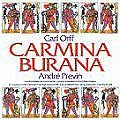 Another, a single line set by Orff as a four-measure soprano melisma, states, "Sweetest boy, I give my all to you" – has there ever been a more complete expression of all-encompassing love? Another, a single line set by Orff as a four-measure soprano melisma, states, "Sweetest boy, I give my all to you" – has there ever been a more complete expression of all-encompassing love?
Although obsessively private, Orff explained his fascination with the ancient texts, which he regarded as "not old but valid; the time element disappears and only the spiritual power remains." He claimed to prefer so-called "dead" languages as more alive than modern ones, full of vivid imagery rather than abstractions: "Long ago, people talked less but more graphically." While the poems themselves had become well known, Orff felt that they needed music as an essential part of their poetry. Indeed, the Carmina manuscript had rudimentary notation that suggested instrumental accompaniment, but its meaning was obscure.
Inspired by his educational work,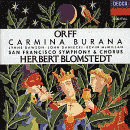 Orff applied the same principles to simplify his musical vocabulary and to craft a seemingly new but timeless style, with a sound that was fresh yet firmly rooted in the past. Plain phrases are repeated rather than developed; rhythms remain constant with little tempo change within a piece; accompaniment usually doubles or briefly comments upon the vocal lines; harmonies are rudimentary, with no counterpoint; keys are firmly established with little modulation or chromatic coloration; vocal writing is in octaves, fifths or thirds with lots of parallel movement; and the instrumentation is dominated by a huge percussion section of 32 instruments and eight players. If all this sounds like punk rock, it has the same appeal of primal energy and a rediscovery of basics. Orff applied the same principles to simplify his musical vocabulary and to craft a seemingly new but timeless style, with a sound that was fresh yet firmly rooted in the past. Plain phrases are repeated rather than developed; rhythms remain constant with little tempo change within a piece; accompaniment usually doubles or briefly comments upon the vocal lines; harmonies are rudimentary, with no counterpoint; keys are firmly established with little modulation or chromatic coloration; vocal writing is in octaves, fifths or thirds with lots of parallel movement; and the instrumentation is dominated by a huge percussion section of 32 instruments and eight players. If all this sounds like punk rock, it has the same appeal of primal energy and a rediscovery of basics.
Some commentators purport to discern fascist overtones in the repetition and simplicity of Orff's style (which, admittedly, emerged in Germany between the Wars). Yet, the texts hardly uphold conservative values, dwelling instead upon lust, decadence and contempt for authority. Indeed, the Nazis generally condemned his percussive sound as tastelessly vulgar. 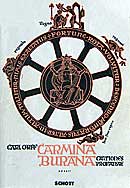 Other detractors deride the work as dumbed-down Stravinsky but, as Tim Page has noted, it "looks forward to a number of compositional trends that were yet to be born," including Copland, Bernstein, Gorecki and even the minimalism of Reich, Glass and others. Page aptly notes: "Nobody but the most antiseptic musical snob need apologize for enjoying - and admiring - Carmina Burana." Other detractors deride the work as dumbed-down Stravinsky but, as Tim Page has noted, it "looks forward to a number of compositional trends that were yet to be born," including Copland, Bernstein, Gorecki and even the minimalism of Reich, Glass and others. Page aptly notes: "Nobody but the most antiseptic musical snob need apologize for enjoying - and admiring - Carmina Burana."
The work announces its essence at the very outset with one of the most oft-quoted of all classical pieces. "O Fortuna" is instantly recognizable and unforgettable, relentlessly building a short killer motif in d-minor without even a hint of harmonic progression. The text is an extended metaphor of life, its joys and frustrations nourished and buffeted by the constant turning of the wheel of fortune. The three major sections that follow trace the resurgence of the human soul amid the follies and rewards of fate, an inexorable force that links all mankind throughout the generations.
The first part, "Primo Vere - Uf Dem Anger" ("Springtime - In the Meadow"), reverts to the dawn of Western music, as chant-like phrases hover over a simple, two-note motif (G to A) and chords of A and E, presenting the simplest tonality (a minor, with no accidentals), the most elementary tonal progression (movement between adjacent notes) and the most basic polytonal interval (an open fifth). Next, a baritone solo introduces simple scalar melody. Rhythm then emerges in a rollicking orchestral dance in common (4/4) time with measures of 1� beats tossed in to disrupt the regularity. Although seemingly a leap into modernistic complexity, actually Orff provides a valuable historical lesson, reminding us that while music has become rhythmically standardized, usually cast in unvarying meters of 4 or occasionally 3, medieval music tended to be far more varied. Indeed, Orff seals the point with a lilting round dance that fluently scrambles measures of 2, 3, 5 and 7 beats. But lest this section appear to be a dry history lesson, Orff concludes it with a macho choral plea to bed the Queen of England (a herald of Paul McCartney's "Her Majesty"?). presenting the simplest tonality (a minor, with no accidentals), the most elementary tonal progression (movement between adjacent notes) and the most basic polytonal interval (an open fifth). Next, a baritone solo introduces simple scalar melody. Rhythm then emerges in a rollicking orchestral dance in common (4/4) time with measures of 1� beats tossed in to disrupt the regularity. Although seemingly a leap into modernistic complexity, actually Orff provides a valuable historical lesson, reminding us that while music has become rhythmically standardized, usually cast in unvarying meters of 4 or occasionally 3, medieval music tended to be far more varied. Indeed, Orff seals the point with a lilting round dance that fluently scrambles measures of 2, 3, 5 and 7 beats. But lest this section appear to be a dry history lesson, Orff concludes it with a macho choral plea to bed the Queen of England (a herald of Paul McCartney's "Her Majesty"?).
In the next part, the resurgent hormones of Orff's salute to spring wind up "In Taberna" ("In the Tavern"), highlighted by a bold aria in which doubts and inhibitions are dissolved by vice and pleasure, the ramblings of a drunken abbot mocked by the crowd, and a dizzy drinking song that offers 13 toasts and then catalogues with accelerating haste all who imbibe ("sister, brother, old maid, mother"). 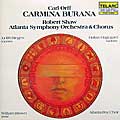 The third section is "Cour d'amours" ("The Court of Love"), an exquisite set of poignant, na�ve and sincere observations that explore the mind of youth, ever tottering on the timeless cusp between innocence and lust, chastity and indulgence. The third section is "Cour d'amours" ("The Court of Love"), an exquisite set of poignant, na�ve and sincere observations that explore the mind of youth, ever tottering on the timeless cusp between innocence and lust, chastity and indulgence.
For his magnificent conclusion, Orff seemingly steps outside his constraints with a fully-harmonized chorus in an ardent salute to the power and fulfillment of love. But then, just as the chorale soars to a dazzling climax and perches on a seemingly decisive cadence, we plunge into an exact repeat of the opening "O Fortuna," thus closing the work with a final warning that life is a vast cycle and that its only guarantee is the uncertainty of fate itself.
In his youth, Orff had been enthralled by the refinement and directness of the early 17th century operas of Monteverdi. 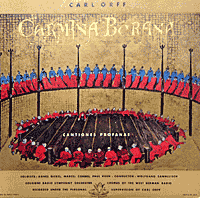 Indeed, Orff insisted that the full import of words and music required staging, and intended Carmina Burana as a theatre piece in which the musicians would be hidden so as not to detract from an on-stage ballet. (The subtitle is "Profane songs for singers and vocal chorus with instruments and magical pictures.") The cover of the Sawallich Angel LP is a design from the 1937 premiere showing fifty choristers on a riser in two rows of red and blue gowns, above 41 in red habits seated with beer steins around a huge wooden table; four appear to have collapsed, one slumped forward and three sprawled on the floor. Although early performances reportedly followed Orff's intentions for staging, nearly all modern productions are in standard concert format. Indeed, Orff insisted that the full import of words and music required staging, and intended Carmina Burana as a theatre piece in which the musicians would be hidden so as not to detract from an on-stage ballet. (The subtitle is "Profane songs for singers and vocal chorus with instruments and magical pictures.") The cover of the Sawallich Angel LP is a design from the 1937 premiere showing fifty choristers on a riser in two rows of red and blue gowns, above 41 in red habits seated with beer steins around a huge wooden table; four appear to have collapsed, one slumped forward and three sprawled on the floor. Although early performances reportedly followed Orff's intentions for staging, nearly all modern productions are in standard concert format.
Upon completing Carmina Burana Orff disavowed all his prior published work as too extravagantly harmonized, insufficiently rhythmic and thickly orchestrated. 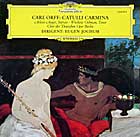 All his further output eschewed the standard songs, symphonies, concertos and even solo or chamber pieces of other composers to focus exclusively upon oratorio and opera. Carmina Burana became the first part of a tryptich. Catulli Carmina (1943) was even bolder in its use and distillation of spare materials. Although scored for four pianos, percussion, solo voices and chorus, all but the opening and closing is a capella, the spell of its intensely rhythmic repetitions occasionally relieved by declamation to tell the tale of the Roman poet Catullus' obsession for a consul's wife. To Orff's trademark ancient texts, unwavering harmonies and parallel motion are added insistent rhythms, extreme dynamics and contrasts between men's and women's voices for an extraordinarily challenging and exhausting yet invigorating singers' workout. All his further output eschewed the standard songs, symphonies, concertos and even solo or chamber pieces of other composers to focus exclusively upon oratorio and opera. Carmina Burana became the first part of a tryptich. Catulli Carmina (1943) was even bolder in its use and distillation of spare materials. Although scored for four pianos, percussion, solo voices and chorus, all but the opening and closing is a capella, the spell of its intensely rhythmic repetitions occasionally relieved by declamation to tell the tale of the Roman poet Catullus' obsession for a consul's wife. To Orff's trademark ancient texts, unwavering harmonies and parallel motion are added insistent rhythms, extreme dynamics and contrasts between men's and women's voices for an extraordinarily challenging and exhausting yet invigorating singers' workout.
The 1951 Trionfo de Afrodite completed the cycle. 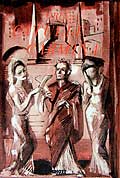 Poetry of Catullus, Sappho and Euripides conjures newlyweds' wedding night, but while the text is a bit impish, the music is unremittingly parched, grim and formally ritualistic without a hint of the expected joy and tenderness of the occasion. Indeed, the bride's deflowering is a cartoonish depiction of screams and moans, sex without love. This display of technique shorn of substance led the way to Orff's final work, his relentlessly bleak and oppressive 1973 De temporum fine comoedia, about the end of the world, a grueling ordeal that seems a world apart from the joyous celebration of life in Carmina Burana. Poetry of Catullus, Sappho and Euripides conjures newlyweds' wedding night, but while the text is a bit impish, the music is unremittingly parched, grim and formally ritualistic without a hint of the expected joy and tenderness of the occasion. Indeed, the bride's deflowering is a cartoonish depiction of screams and moans, sex without love. This display of technique shorn of substance led the way to Orff's final work, his relentlessly bleak and oppressive 1973 De temporum fine comoedia, about the end of the world, a grueling ordeal that seems a world apart from the joyous celebration of life in Carmina Burana.
Frankly, I've never heard a recording of Carmina Burana that fully integrates Orff's unwavering ardent simplicity and elemental visceral impact. The first recording of the complete Trionfi cycle by Eugen Jochum and the Bavarian Radio Symphony Orchestra and Chorus in 1952-5 (DG) is fast and steady, with a natural expressive ease and conversational solos – vibrant without being forced. 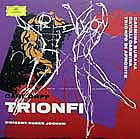 All these qualities are preserved and enhanced in their 1967 stereo remake (DG). All these qualities are preserved and enhanced in their 1967 stereo remake (DG).
While the Jochum remake claims to be "authorized" by Orff, a 1957 recording by Wolfgang Sawallich, the West German Radio Chorus and the Cologne Radio Symphony Orchestra (Angel LP) states that it was "recorded under the personal supervision of the composer." Perhaps reflecting Orff's pride in the craftsmanship of his score, the performance boasts prominent percussive effects, emphatic acompanying figures, strong dynamic contrasts ("O fortuna" doesn't build to its climax but explodes), playing and singing of pronounced character (the introduction to the roasting swan brims with mischief) and, while the timings are quite similar to Jochum's, highly flexible tempos.
Of other admired recordings, many disappoint. Ormandy/Philadelphia (Sony, 1960) is similarly fleet but its fine, spirited singing is compromised by bland accompaniment with suppressed tympani – smooth but missing the essence of Orff's concept. 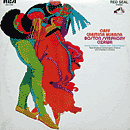 Levine/Chicago (DG) is attentive but rather literal and dry, Ozawa/Boston (RCA) and Fr�hbeck de Burgos/New Philharmonia (EMI) sputter to life only briefly toward the end, and Stokowski/Houston (EMI), disfigured with quirky balances and deep cuts, emerges as stodgy and surprisingly soulless. Levine/Chicago (DG) is attentive but rather literal and dry, Ozawa/Boston (RCA) and Fr�hbeck de Burgos/New Philharmonia (EMI) sputter to life only briefly toward the end, and Stokowski/Houston (EMI), disfigured with quirky balances and deep cuts, emerges as stodgy and surprisingly soulless.
Alongside Jochum's are many other noteworthy recordings. Blomstedt/San Francisco (Decca) is vibrant, sharp and bursting with life and an ample helping of wit; Tilson-Thomas/Cleveland (Sony) is youthful and dynamic, with striking tempo extremes; Muti/Philharmonia (EMI) is highly theatrical and atmospheric, with full-blooded climaxes and exquisite repose; 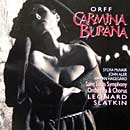 Previn/London (EMI) combines more judicious tempos with precise enunciation for a spirited, brash and even occasionally rude texture; Slatkin/St. Louis (BMG) is rich, impulsive and deeply humanistic, with superb solo singing (including tenor John Aler, who really stretches for the high notes without falsetto to invoke the roasting swan), but disappoints only with a timid conclusion; Shaw/Atlanta (Telarc) is comparatively straightforward, its especially agile choral work captured with crystalline clarity by the early (1980) digital process (and a bass drum that will justify all that money you spent on a sub-woofer). (Although Runnicles/Atlanta (Telarc) claims to reach for an extra measure of authenticity by restoring 13th century diction, the differences between it and the same forces in the Shaw recordings are mighty subtle.) Previn/London (EMI) combines more judicious tempos with precise enunciation for a spirited, brash and even occasionally rude texture; Slatkin/St. Louis (BMG) is rich, impulsive and deeply humanistic, with superb solo singing (including tenor John Aler, who really stretches for the high notes without falsetto to invoke the roasting swan), but disappoints only with a timid conclusion; Shaw/Atlanta (Telarc) is comparatively straightforward, its especially agile choral work captured with crystalline clarity by the early (1980) digital process (and a bass drum that will justify all that money you spent on a sub-woofer). (Although Runnicles/Atlanta (Telarc) claims to reach for an extra measure of authenticity by restoring 13th century diction, the differences between it and the same forces in the Shaw recordings are mighty subtle.)
The weirdest of all Carmina Burana recordings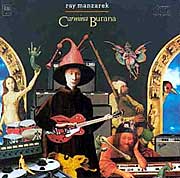 is a 1983 "arrangement" by Doors keyboardist Ray Manzarek (A&M). is a 1983 "arrangement" by Doors keyboardist Ray Manzarek (A&M).  Although intended to channel the work's spiritual power to create "an enhanced intense feeling for life akin to the passion and revelry of the wandering poets of so long ago," the constant volume, unremitting thudding downbeats, thick rock texture, echo-drenched vocals and added instrumental breaks are far more disco than retro. (The uncredited cover art, though, is a riot, with sundry medieval folk devoutly playing rock instruments.) Yet, the disconcerting clash of serious and pop cultures spawns a wholly appropriate application of Orff's core insistence that music be purified and recast into primal rhythms. Although intended to channel the work's spiritual power to create "an enhanced intense feeling for life akin to the passion and revelry of the wandering poets of so long ago," the constant volume, unremitting thudding downbeats, thick rock texture, echo-drenched vocals and added instrumental breaks are far more disco than retro. (The uncredited cover art, though, is a riot, with sundry medieval folk devoutly playing rock instruments.) Yet, the disconcerting clash of serious and pop cultures spawns a wholly appropriate application of Orff's core insistence that music be purified and recast into primal rhythms.

Copyright 2005 by Peter Gutmann
|
